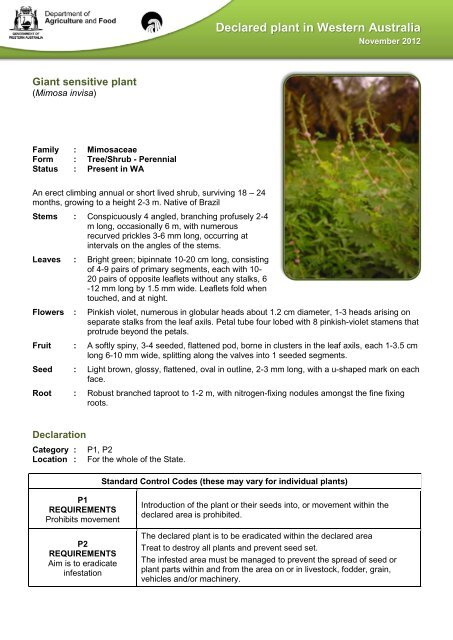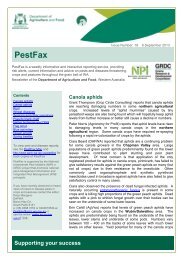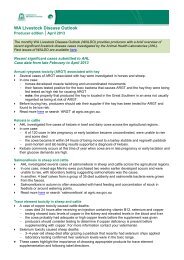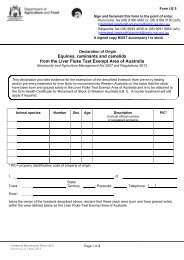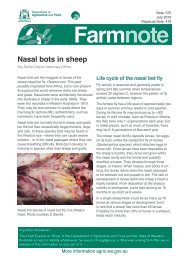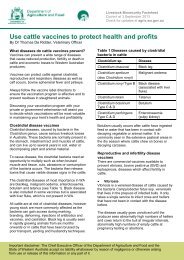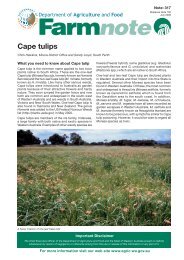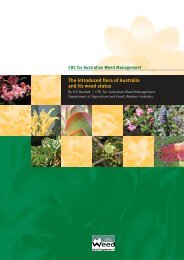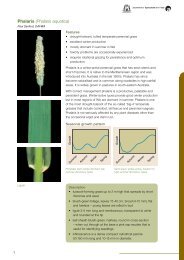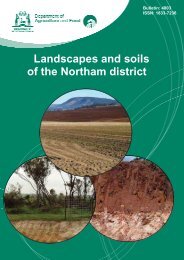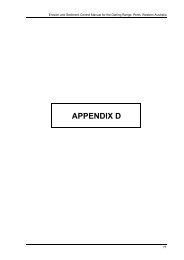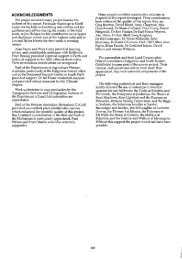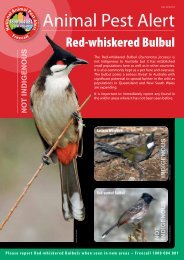pudica
pudica
pudica
Create successful ePaper yourself
Turn your PDF publications into a flip-book with our unique Google optimized e-Paper software.
Declared plant in Western Australia<br />
November 2012<br />
Giant sensitive plant<br />
(Mimosa invisa)<br />
Family : Mimosaceae<br />
Form : Tree/Shrub - Perennial<br />
Status : Present in WA<br />
An erect climbing annual or short lived shrub, surviving 18 – 24<br />
months, growing to a height 2-3 m. Native of Brazil<br />
Stems : Conspicuously 4 angled, branching profusely 2-4<br />
m long, occasionally 6 m, with numerous<br />
recurved prickles 3-6 mm long, occurring at<br />
intervals on the angles of the stems.<br />
Leaves : Bright green; bipinnate 10-20 cm long, consisting<br />
of 4-9 pairs of primary segments, each with 10-<br />
20 pairs of opposite leaflets without any stalks, 6<br />
-12 mm long by 1.5 mm wide. Leaflets fold when<br />
touched, and at night.<br />
Flowers : Pinkish violet, numerous in globular heads about 1.2 cm diameter, 1-3 heads arising on<br />
separate stalks from the leaf axils. Petal tube four lobed with 8 pinkish-violet stamens that<br />
protrude beyond the petals.<br />
Fruit : A softly spiny, 3-4 seeded, flattened pod, borne in clusters in the leaf axils, each 1-3.5 cm<br />
long 6-10 mm wide, splitting along the valves into 1 seeded segments.<br />
Seed : Light brown, glossy, flattened, oval in outline, 2-3 mm long, with a u-shaped mark on each<br />
face.<br />
Root : Robust branched taproot to 1-2 m, with nitrogen-fixing nodules amongst the fine fixing<br />
roots.<br />
Declaration<br />
Category : P1, P2<br />
Location : For the whole of the State.<br />
Standard Control Codes (these may vary for individual plants)<br />
P1<br />
REQUIREMENTS<br />
Prohibits movement<br />
P2<br />
REQUIREMENTS<br />
Aim is to eradicate<br />
infestation<br />
Introduction of the plant or their seeds into, or movement within the<br />
declared area is prohibited.<br />
The declared plant is to be eradicated within the declared area<br />
Treat to destroy all plants and prevent seed set.<br />
The infested area must be managed to prevent the spread of seed or<br />
plant parts within and from the area on or in livestock, fodder, grain,<br />
vehicles and/or machinery.
Giant sensitive plant (Mimosa invisa) - Declared plant in Western Australia<br />
Control Method<br />
Recommended herbicides : Actively growing<br />
Fluroxypyr<br />
Herbicide<br />
Basta®<br />
Active ingredient 200 g/litre glufosinate ammonium (Group N)<br />
Amount of product per 10<br />
litres water<br />
Rate of product per hectare<br />
20 - 50 mL<br />
2 - 5 litres<br />
Wetting agent dilution 1:400<br />
Time of application<br />
Remarks<br />
More information and other<br />
control methods<br />
Apply when actively growing.<br />
Cover all foliage thoroughly.<br />
Registered for M. invisa (common sensitive plant only).<br />
Follow-up treatment usually required.<br />
Dicamba @20 mL/10 L; also effective on M. <strong>pudica</strong><br />
Herbicide : Fluroxypyr<br />
Active ingredient : 200 g/litre fluroxypyr (Group I)<br />
Rates of dilution for spot : 0.15 litres per 100 litres water<br />
spraying<br />
Amount of product per 10<br />
litres water<br />
: 50 mL for Common sensitive (M. <strong>pudica</strong>)<br />
30 mL for Giant sensitive plant<br />
Rate of product per hectare : 1.3 - 1.5 litre<br />
Wetting agent dilution : 1:400 Non- ionic wetting agent or Uptake® spraying oil<br />
Time of application : Actively growing before flowering<br />
Remarks : Will kill legumes<br />
More information and other<br />
control methods<br />
: Aerial application of 3 L/ha for M. pigra.<br />
Also Grazon® DS is registered for sensitive plant.<br />
Also formulations containing 333 and 400 g/L available<br />
Herbicide : Cadence<br />
Active ingredient : 700 g/kg dicamba (Group I)<br />
Amount of product per 10 : 30 g<br />
litres water<br />
Rate of product per hectare 1430-1700 g Registered in NT for Mimosa pigra<br />
Time of application : Actively growing plants, preferably during the wet season.<br />
Retreatment may be necessary to control new germination of<br />
seedlings.<br />
More information and other : High volume – Thoroughly wet all leaves and stems<br />
control methods<br />
Basal bark – spray all around base and 25-40 cm up the stem.<br />
Only apply plants < 5 cm basal diameter<br />
Cut stump – apply to plants up to 10 cm basal diameter. Cut<br />
trees as close to ground as possible and spray immediately<br />
before sap dries.<br />
Herbicide : Triclopyr + picloram<br />
(various trade names - APVMA site)<br />
Active ingredient : 300 g/L tryclopyr + 100 g/L picloram (Group I)<br />
Amount of product per 10 : 20 mL<br />
litres water<br />
Wetting agent : Use 100% non-ionic wetting agent such as BS-1000<br />
More information and other<br />
control methods<br />
: Try to avoid causing leaves to fold up before spraying.<br />
2
Giant sensitive plant (Mimosa invisa) - Declared plant in Western Australia<br />
Other relevant information related to this topic:<br />
Quarantine WA<br />
Permitted and quarantine species list<br />
Off-label permit of a registered agvet chemical product<br />
(Declared plants: Permit number – per13236)<br />
Off-label permit (olp) for use of a registered agvet chemical product<br />
(Environmental weeds: Permit number – per13333)<br />
3


